Case Study: Healthcare Reforms for Vulnerable Populations in a State
VerifiedAdded on 2020/03/16
|6
|1490
|281
Case Study
AI Summary
This case study analyzes the steps a state governor would take to reform healthcare and services delivery to increase access for vulnerable populations. The governor plans to form a task force of experienced healthcare professionals and identify stakeholders, including healthcare leaders. The process involves gathering input through proposals, meetings, and online research while limiting inappropriate influence. The case study addresses potential challenges such as a weak safety net, language and cultural barriers, and education levels. Proposed solutions include enhancing security, providing language translation services, and offering educational programs. The governor aims for meaningful reforms within six months, emphasizing stakeholder cooperation and the application of solutions. References from various healthcare and public health sources support the analysis.
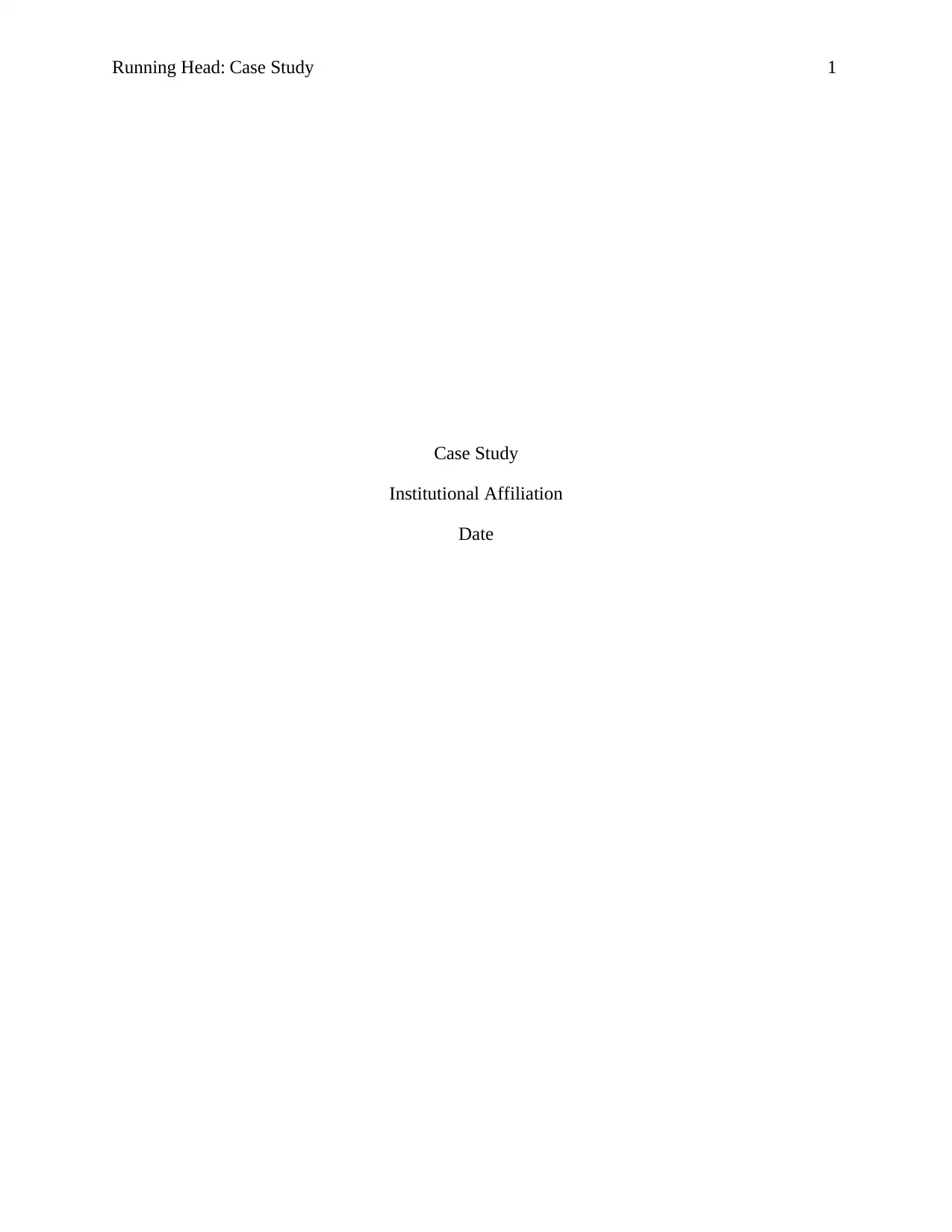
Running Head: Case Study 1
Case Study
Institutional Affiliation
Date
Case Study
Institutional Affiliation
Date
Paraphrase This Document
Need a fresh take? Get an instant paraphrase of this document with our AI Paraphraser

CASE STUDY 2
Case Study
As the Governor of a midsized industrial State, I would like to make reforms to the
healthcare and services delivery systems in my state to increase access to care for the vulnerable
populations. In order to achieve that, there are steps that I would take in order to ensure that I
proceed in my undertaking. The process would require me to go ahead with my plans in an
organized manner in order to ensure that I achieve that goal. First I would be required to choose
the individuals who will serve in my task force in this work. I would also be required to identify
the stakeholders in this particular exercise. I would also be needed to determine how I would
obtain their input and how I would control any influence that is not appropriate. It would also be
necessary for me to know the challenges that would come my way and know how to address
them. It is necessary also to know the solutions that I would have in order to ensure that my plan
succeeds (Power, 2003). I would also be required to know how I possible it would be to come up
with meaningful reform and the duration it would take.
In order to succeed in my endeavor, I would choose individuals who are experienced in
the field of healthcare so that they would assist me in carrying out the activity. The learned
individuals would help me go ahead with my project easily since they know more about what I
would be doing. For instance, I would include friends who are nurses or who have the knowledge
in healthcare more than I do since they would comprise of more ideas on how to go about the
particular activity.
The stakeholders in this activity would be the health professionals and other healthcare
leaders in the hospitals within my state. I would select individuals who are involved in providing
health care to patients within the state. The individuals would help me to carry on the exercise
with ease since they have the experience of what it takes to make healthcare accessible to the
Case Study
As the Governor of a midsized industrial State, I would like to make reforms to the
healthcare and services delivery systems in my state to increase access to care for the vulnerable
populations. In order to achieve that, there are steps that I would take in order to ensure that I
proceed in my undertaking. The process would require me to go ahead with my plans in an
organized manner in order to ensure that I achieve that goal. First I would be required to choose
the individuals who will serve in my task force in this work. I would also be required to identify
the stakeholders in this particular exercise. I would also be needed to determine how I would
obtain their input and how I would control any influence that is not appropriate. It would also be
necessary for me to know the challenges that would come my way and know how to address
them. It is necessary also to know the solutions that I would have in order to ensure that my plan
succeeds (Power, 2003). I would also be required to know how I possible it would be to come up
with meaningful reform and the duration it would take.
In order to succeed in my endeavor, I would choose individuals who are experienced in
the field of healthcare so that they would assist me in carrying out the activity. The learned
individuals would help me go ahead with my project easily since they know more about what I
would be doing. For instance, I would include friends who are nurses or who have the knowledge
in healthcare more than I do since they would comprise of more ideas on how to go about the
particular activity.
The stakeholders in this activity would be the health professionals and other healthcare
leaders in the hospitals within my state. I would select individuals who are involved in providing
health care to patients within the state. The individuals would help me to carry on the exercise
with ease since they have the experience of what it takes to make healthcare accessible to the
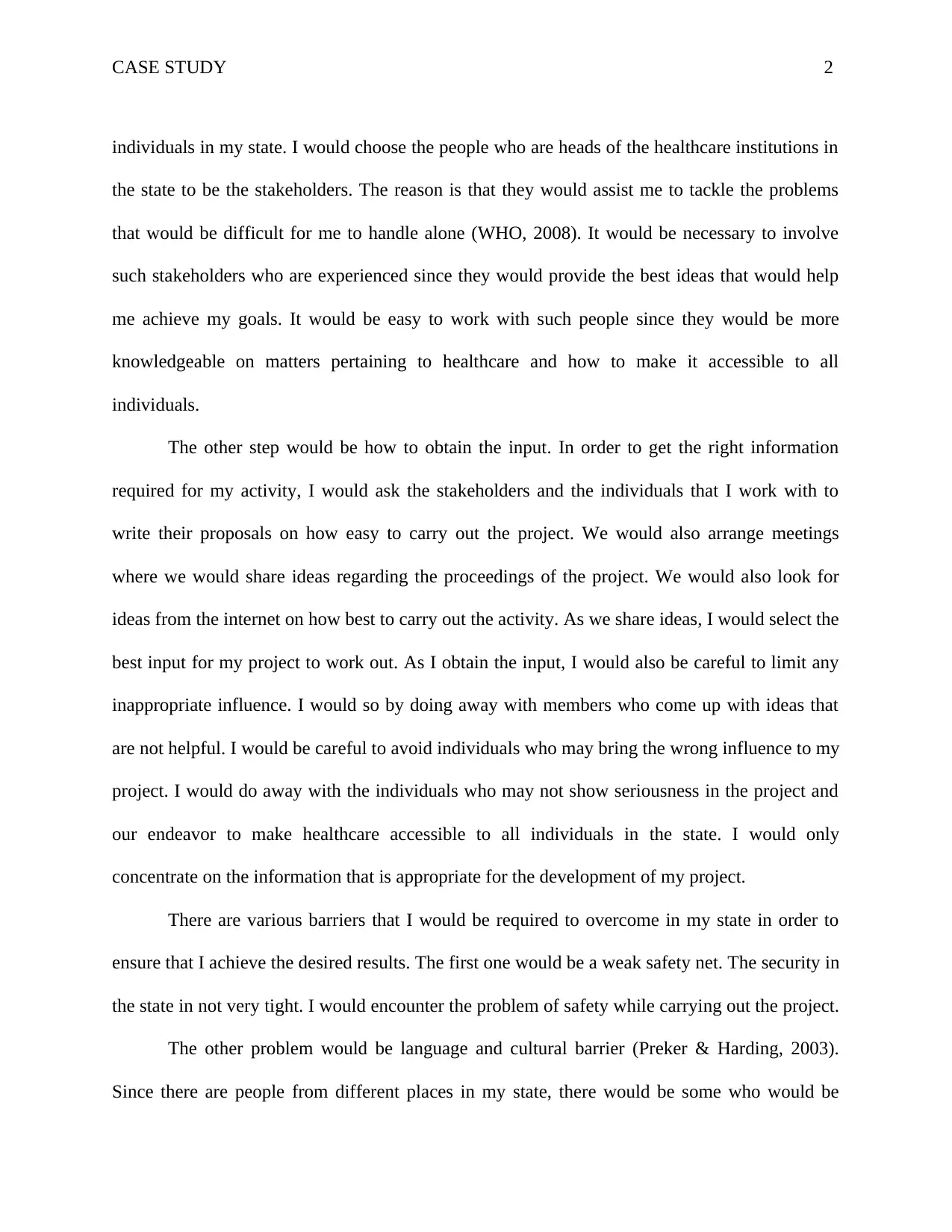
CASE STUDY 2
individuals in my state. I would choose the people who are heads of the healthcare institutions in
the state to be the stakeholders. The reason is that they would assist me to tackle the problems
that would be difficult for me to handle alone (WHO, 2008). It would be necessary to involve
such stakeholders who are experienced since they would provide the best ideas that would help
me achieve my goals. It would be easy to work with such people since they would be more
knowledgeable on matters pertaining to healthcare and how to make it accessible to all
individuals.
The other step would be how to obtain the input. In order to get the right information
required for my activity, I would ask the stakeholders and the individuals that I work with to
write their proposals on how easy to carry out the project. We would also arrange meetings
where we would share ideas regarding the proceedings of the project. We would also look for
ideas from the internet on how best to carry out the activity. As we share ideas, I would select the
best input for my project to work out. As I obtain the input, I would also be careful to limit any
inappropriate influence. I would so by doing away with members who come up with ideas that
are not helpful. I would be careful to avoid individuals who may bring the wrong influence to my
project. I would do away with the individuals who may not show seriousness in the project and
our endeavor to make healthcare accessible to all individuals in the state. I would only
concentrate on the information that is appropriate for the development of my project.
There are various barriers that I would be required to overcome in my state in order to
ensure that I achieve the desired results. The first one would be a weak safety net. The security in
the state in not very tight. I would encounter the problem of safety while carrying out the project.
The other problem would be language and cultural barrier (Preker & Harding, 2003).
Since there are people from different places in my state, there would be some who would be
individuals in my state. I would choose the people who are heads of the healthcare institutions in
the state to be the stakeholders. The reason is that they would assist me to tackle the problems
that would be difficult for me to handle alone (WHO, 2008). It would be necessary to involve
such stakeholders who are experienced since they would provide the best ideas that would help
me achieve my goals. It would be easy to work with such people since they would be more
knowledgeable on matters pertaining to healthcare and how to make it accessible to all
individuals.
The other step would be how to obtain the input. In order to get the right information
required for my activity, I would ask the stakeholders and the individuals that I work with to
write their proposals on how easy to carry out the project. We would also arrange meetings
where we would share ideas regarding the proceedings of the project. We would also look for
ideas from the internet on how best to carry out the activity. As we share ideas, I would select the
best input for my project to work out. As I obtain the input, I would also be careful to limit any
inappropriate influence. I would so by doing away with members who come up with ideas that
are not helpful. I would be careful to avoid individuals who may bring the wrong influence to my
project. I would do away with the individuals who may not show seriousness in the project and
our endeavor to make healthcare accessible to all individuals in the state. I would only
concentrate on the information that is appropriate for the development of my project.
There are various barriers that I would be required to overcome in my state in order to
ensure that I achieve the desired results. The first one would be a weak safety net. The security in
the state in not very tight. I would encounter the problem of safety while carrying out the project.
The other problem would be language and cultural barrier (Preker & Harding, 2003).
Since there are people from different places in my state, there would be some who would be
⊘ This is a preview!⊘
Do you want full access?
Subscribe today to unlock all pages.

Trusted by 1+ million students worldwide
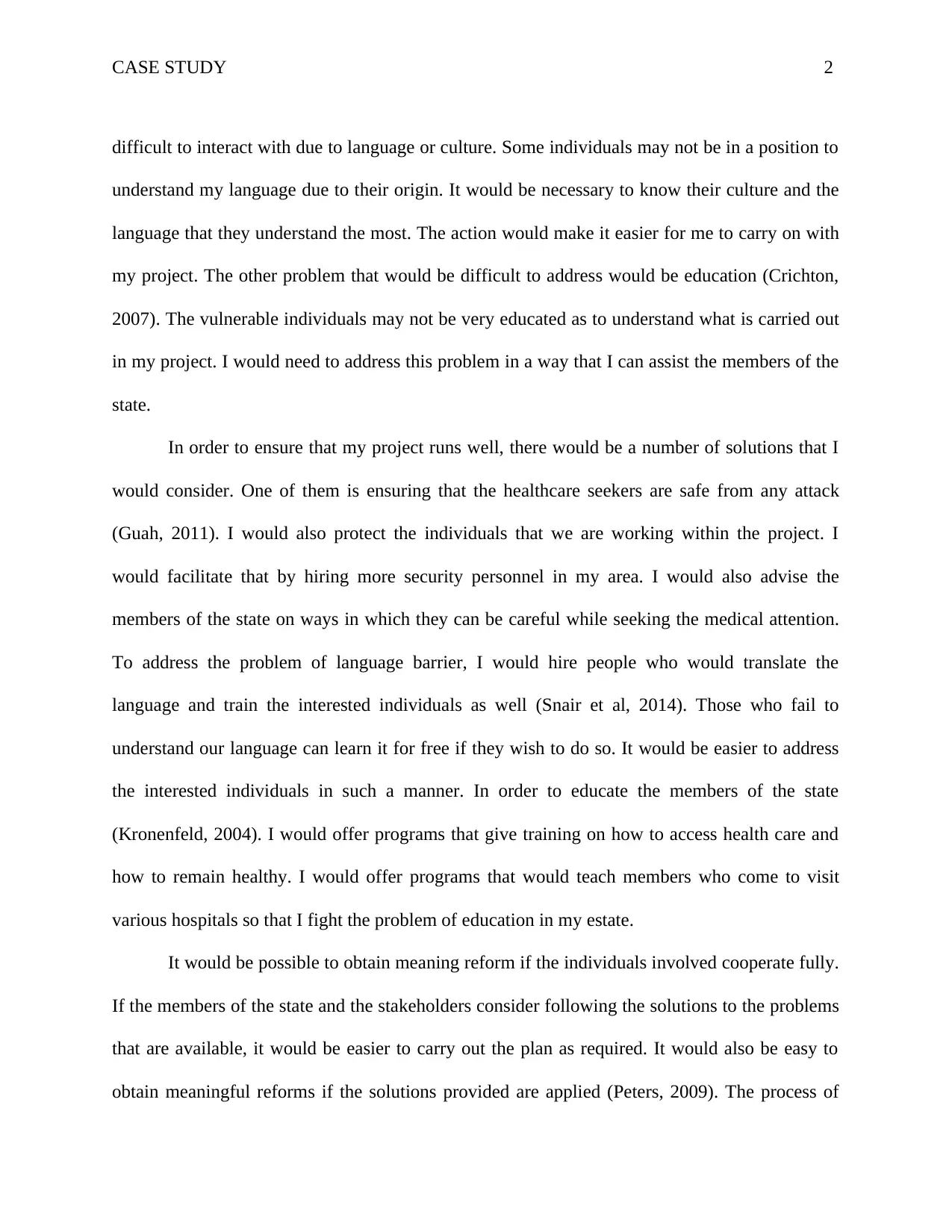
CASE STUDY 2
difficult to interact with due to language or culture. Some individuals may not be in a position to
understand my language due to their origin. It would be necessary to know their culture and the
language that they understand the most. The action would make it easier for me to carry on with
my project. The other problem that would be difficult to address would be education (Crichton,
2007). The vulnerable individuals may not be very educated as to understand what is carried out
in my project. I would need to address this problem in a way that I can assist the members of the
state.
In order to ensure that my project runs well, there would be a number of solutions that I
would consider. One of them is ensuring that the healthcare seekers are safe from any attack
(Guah, 2011). I would also protect the individuals that we are working within the project. I
would facilitate that by hiring more security personnel in my area. I would also advise the
members of the state on ways in which they can be careful while seeking the medical attention.
To address the problem of language barrier, I would hire people who would translate the
language and train the interested individuals as well (Snair et al, 2014). Those who fail to
understand our language can learn it for free if they wish to do so. It would be easier to address
the interested individuals in such a manner. In order to educate the members of the state
(Kronenfeld, 2004). I would offer programs that give training on how to access health care and
how to remain healthy. I would offer programs that would teach members who come to visit
various hospitals so that I fight the problem of education in my estate.
It would be possible to obtain meaning reform if the individuals involved cooperate fully.
If the members of the state and the stakeholders consider following the solutions to the problems
that are available, it would be easier to carry out the plan as required. It would also be easy to
obtain meaningful reforms if the solutions provided are applied (Peters, 2009). The process of
difficult to interact with due to language or culture. Some individuals may not be in a position to
understand my language due to their origin. It would be necessary to know their culture and the
language that they understand the most. The action would make it easier for me to carry on with
my project. The other problem that would be difficult to address would be education (Crichton,
2007). The vulnerable individuals may not be very educated as to understand what is carried out
in my project. I would need to address this problem in a way that I can assist the members of the
state.
In order to ensure that my project runs well, there would be a number of solutions that I
would consider. One of them is ensuring that the healthcare seekers are safe from any attack
(Guah, 2011). I would also protect the individuals that we are working within the project. I
would facilitate that by hiring more security personnel in my area. I would also advise the
members of the state on ways in which they can be careful while seeking the medical attention.
To address the problem of language barrier, I would hire people who would translate the
language and train the interested individuals as well (Snair et al, 2014). Those who fail to
understand our language can learn it for free if they wish to do so. It would be easier to address
the interested individuals in such a manner. In order to educate the members of the state
(Kronenfeld, 2004). I would offer programs that give training on how to access health care and
how to remain healthy. I would offer programs that would teach members who come to visit
various hospitals so that I fight the problem of education in my estate.
It would be possible to obtain meaning reform if the individuals involved cooperate fully.
If the members of the state and the stakeholders consider following the solutions to the problems
that are available, it would be easier to carry out the plan as required. It would also be easy to
obtain meaningful reforms if the solutions provided are applied (Peters, 2009). The process of
Paraphrase This Document
Need a fresh take? Get an instant paraphrase of this document with our AI Paraphraser
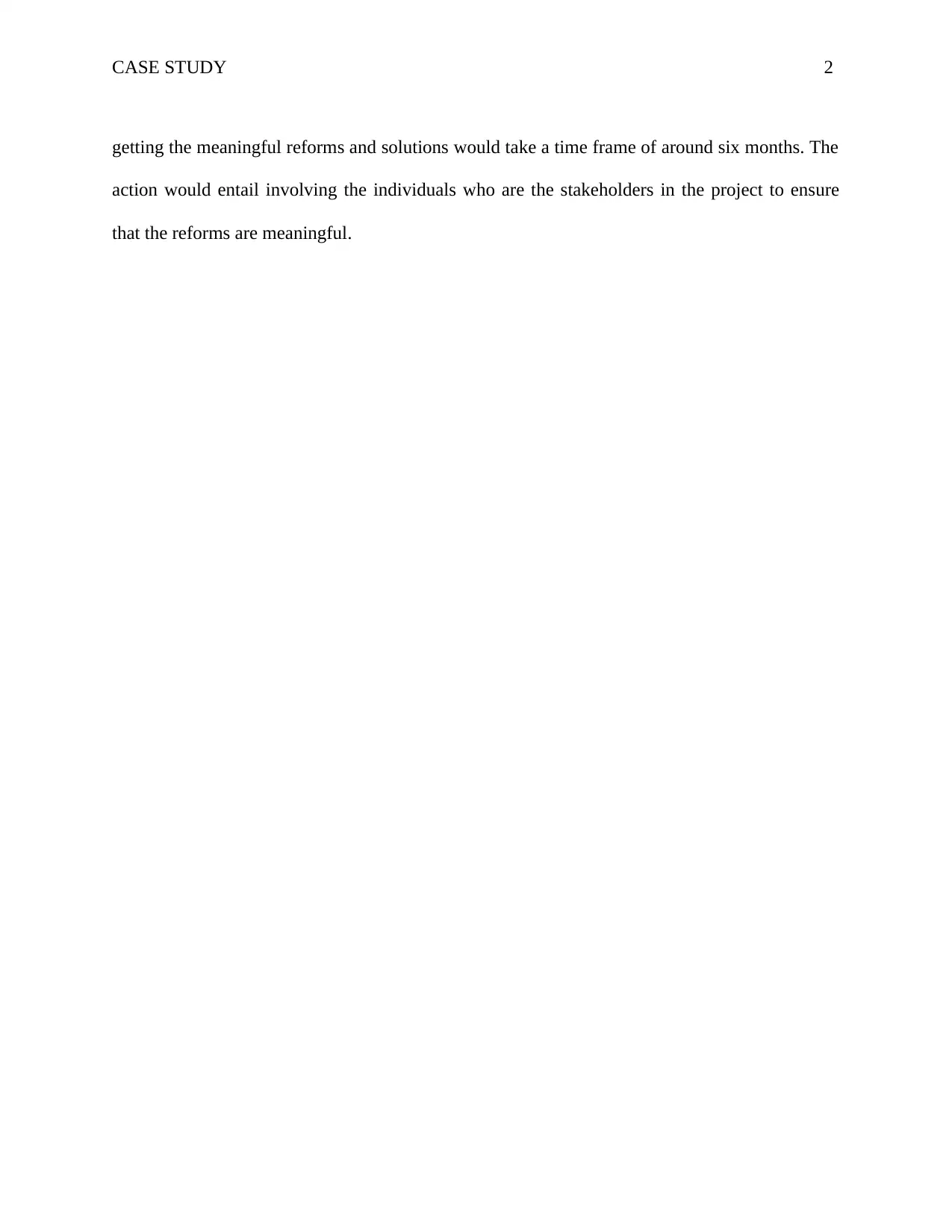
CASE STUDY 2
getting the meaningful reforms and solutions would take a time frame of around six months. The
action would entail involving the individuals who are the stakeholders in the project to ensure
that the reforms are meaningful.
getting the meaningful reforms and solutions would take a time frame of around six months. The
action would entail involving the individuals who are the stakeholders in the project to ensure
that the reforms are meaningful.
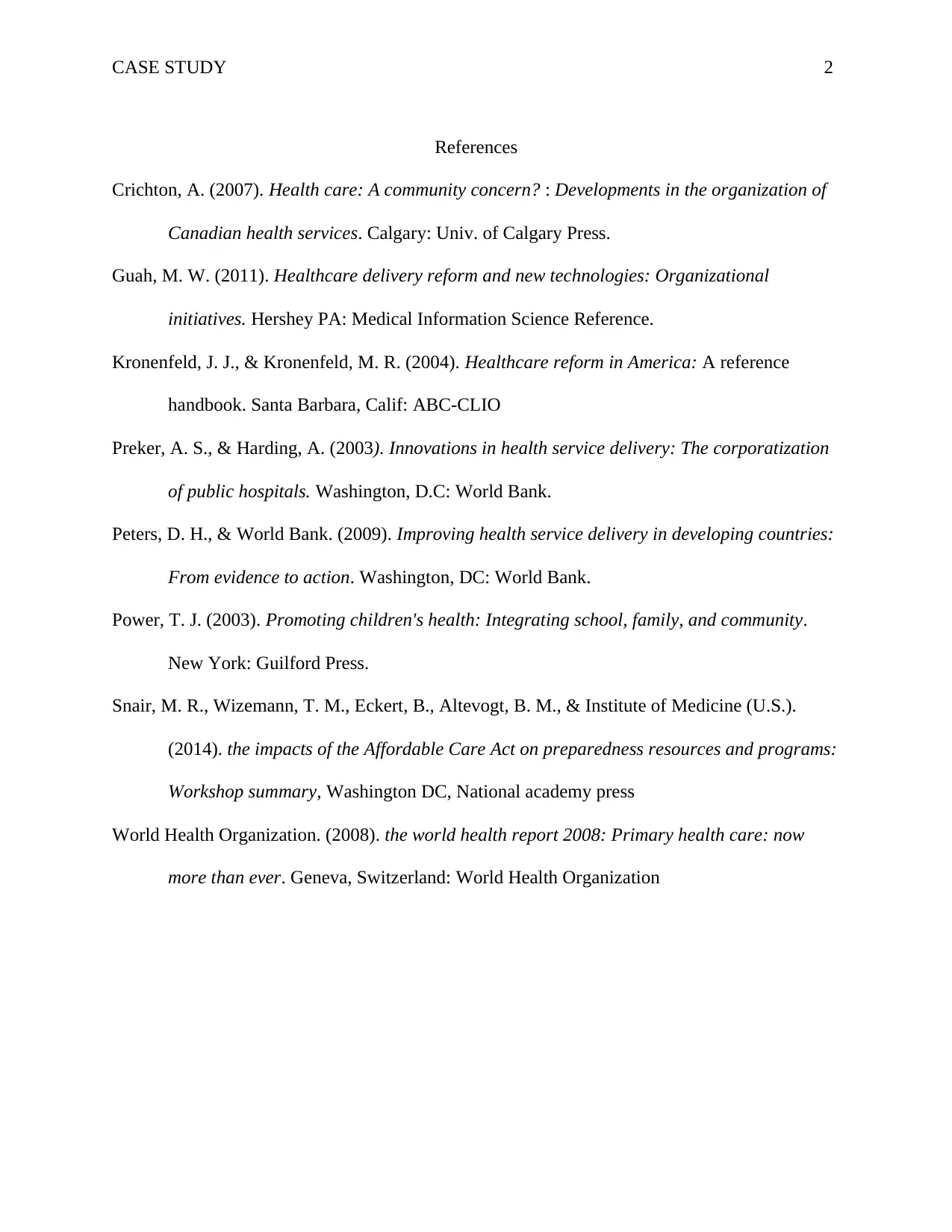
CASE STUDY 2
References
Crichton, A. (2007). Health care: A community concern? : Developments in the organization of
Canadian health services. Calgary: Univ. of Calgary Press.
Guah, M. W. (2011). Healthcare delivery reform and new technologies: Organizational
initiatives. Hershey PA: Medical Information Science Reference.
Kronenfeld, J. J., & Kronenfeld, M. R. (2004). Healthcare reform in America: A reference
handbook. Santa Barbara, Calif: ABC-CLIO
Preker, A. S., & Harding, A. (2003). Innovations in health service delivery: The corporatization
of public hospitals. Washington, D.C: World Bank.
Peters, D. H., & World Bank. (2009). Improving health service delivery in developing countries:
From evidence to action. Washington, DC: World Bank.
Power, T. J. (2003). Promoting children's health: Integrating school, family, and community.
New York: Guilford Press.
Snair, M. R., Wizemann, T. M., Eckert, B., Altevogt, B. M., & Institute of Medicine (U.S.).
(2014). the impacts of the Affordable Care Act on preparedness resources and programs:
Workshop summary, Washington DC, National academy press
World Health Organization. (2008). the world health report 2008: Primary health care: now
more than ever. Geneva, Switzerland: World Health Organization
References
Crichton, A. (2007). Health care: A community concern? : Developments in the organization of
Canadian health services. Calgary: Univ. of Calgary Press.
Guah, M. W. (2011). Healthcare delivery reform and new technologies: Organizational
initiatives. Hershey PA: Medical Information Science Reference.
Kronenfeld, J. J., & Kronenfeld, M. R. (2004). Healthcare reform in America: A reference
handbook. Santa Barbara, Calif: ABC-CLIO
Preker, A. S., & Harding, A. (2003). Innovations in health service delivery: The corporatization
of public hospitals. Washington, D.C: World Bank.
Peters, D. H., & World Bank. (2009). Improving health service delivery in developing countries:
From evidence to action. Washington, DC: World Bank.
Power, T. J. (2003). Promoting children's health: Integrating school, family, and community.
New York: Guilford Press.
Snair, M. R., Wizemann, T. M., Eckert, B., Altevogt, B. M., & Institute of Medicine (U.S.).
(2014). the impacts of the Affordable Care Act on preparedness resources and programs:
Workshop summary, Washington DC, National academy press
World Health Organization. (2008). the world health report 2008: Primary health care: now
more than ever. Geneva, Switzerland: World Health Organization
⊘ This is a preview!⊘
Do you want full access?
Subscribe today to unlock all pages.

Trusted by 1+ million students worldwide
1 out of 6
Related Documents
Your All-in-One AI-Powered Toolkit for Academic Success.
+13062052269
info@desklib.com
Available 24*7 on WhatsApp / Email
![[object Object]](/_next/static/media/star-bottom.7253800d.svg)
Unlock your academic potential
Copyright © 2020–2025 A2Z Services. All Rights Reserved. Developed and managed by ZUCOL.





